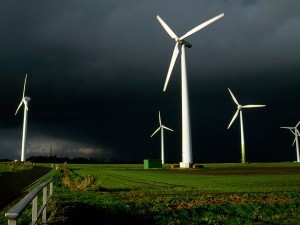
According to the International Energy Agency (IEA), investment in fossil fuel projects over the next quarter century is expected to outpace investment in renewable energy by a ratio of three to one. If we are to solve the most fundamental and pressing problem humanity faces—climate change—the IEA’s forecast will need to be proved wrong. This paper argues that feed-in tariffs (FITs) deserve serious consideration as perhaps the best of the renewable energy implementation tools, the mechanism cited as the primary reason for the success of the German renewable energy markets.
If implemented world-wide, FITs will lead to more than a 25-gigaton reduction in carbon, the amount of carbon needed to compose one climate mitigation wedge in the scheme developed by Robert Socolow and Stephen Pacala. Their idea is that an assemblage of 25-gigaton “stabilization wedges” can lead to the stabilization of carbon emissions in the next fifty years. Because FITs cause more renewable energy sources to come online and fossil-fuel plants to go offline, their implementation can lead to significant reductions in CO2 emissions. Successful implementation of FITs in the United States alone could create the required 25-gigaton reduction just by replacing coal-fired power plants with either wind or solar generation.
Section II of this paper describes feed-in tariffs, what they are and how they support renewable energy generation. Section III covers the details of what an effective FIT looks like. Section IV describes the benefits attending FITs in general. Germany’s remarkable success with FITs is described in Section V. Sections VI and VII cover the United States, and include an analysis of the particular constitutional challenges this country faces in implementing FITs.
I. What Are Feed-In Tariffs?
One of the best ways to support implementation of renewable energy is through feed-in tariffs. German Parliament member Hans-Josef Fell concluded, “[f]eed-in tariffs have proven to be the best support mechanism to rapidly increase the share of renewable energy production and use.”
FITs are somewhat like net metering where homeowners are compensated for energy they put back in the grid from their rooftop solar panels. With net metering, if solar panels are producing more energy than is being used, the meter will run backwards and a credit for the amount of energy being produced will be issued. With net metering the rate is the same as the rate paid for electricity, but with a feed-in tariff, the rate paid can be higher.
Whereas Renewable Portfolio Standards (RPSs) set goals for renewables, FITs provide a mechanism for more inclusion of renewables without necessarily facing upper limits as with RPSs.
FITs typically contain three key provisions:
1) guaranteed grid access,
2) long-term contracts, and
3) cost-based purchase prices.
The first provision, guaranteed access to the grid, is important for encouraging investment. “Purchase obligation is one of the most important ‘ingredients’ for all FITs as it assures investment security. It obliges the nearest grid operator to purchase and distribute all electricity that is produced by renewable energy sources, independent of power demand.” (D Jacobs, BK Sovacool, “Feed-In Tariffs and Other Support Mechanisms for Solar PV Promotion” (2012), at 94.) The second provision, long-term contracts, also helps ensure investor interest by guaranteeing fixed tariff payment over a period of many years.
The third provision, cost-based purchase prices, levels the playing field with existing production sources, ensuring renewables’ attractiveness to potential suppliers. FITs set fixed prices, the rate reflecting both the actual generation cost for each renewable energy technology plus a reasonable rate of return. Tariffs may differ by technology (e.g., wind or solar), location (e.g., rooftop or ground-mounted for solar PV projects), and size (e.g., residential or commercial scale). Costs of a FIT are passed on to consumers and reflect a public policy decision to increase the amount of renewable electricity used.
II. Getting FITs Right
The idea with FITs is to provide a balance between investment security for producers on the one hand and elimination of windfall profits on the other. One of the key questions concerns what to set the tariff price at. A tariff that is too low will not encourage investment in the targeted renewables while a tariff that is too high could lead to unreasonable costs for the consumer. In Europe, where FITs have been successfully employed for years, tariff levels have been set to allow for a rate of return between 5 and 10 percent on investment per year. The profitability of renewable energy generations needs to be as high or higher than for conventional electricity generations to provide an incentive to invest in cleaner forms of energy. FITs are generally financed via a small charge on the electricity price for consumers so that additional costs are distributed among all ratepayers.
FIT legislation can be set up with targets for renewable energies. “[T]argets are important in signaling long-term political commitment to investors. They indicate that support mechanisms will remain in place for a certain period of time and they will increase the likelihood of tariffs being sufficiently high.” (Miguel Mendonca, David Jacobs, and Benjamin Sovacool, “Powering the Green Economy: The Feed-in Tariff Handbook,” at 35.)
Another important aspect of FITs is the purchase obligation, which also assures investment security. The purchase obligation requires the nearest grid operator to purchase and distribute all electricity that is produced by renewable energy sources, independent of power demand. So in times of low demand, “the grid operator will reduce the amount of ‘grey’ electricity while all ‘green’ electricity is incorporated into the electricity mix.” (“Powering,” at 30.)
Because of technological evolution of renewables and growing economies of scale, it can be safely anticipated that costs for renewable energy sources will go down over time. “Tariff degression” takes account of this by automatically reducing tariffs over time, usually on an annual basis. The rate of degression will vary, depending on the technology. Mature technologies, such as wind power, have a low degression rate rate. In Germany, for instance, the tariff is reduced by 1 percent every year. Technologies whose generation costs are still declining rapidly will need to have a higher degression rate. The degression rate in Germany for solar PV, for example, is high as 10 percent per year.
The price level of a tariff is key to its successful implementation. “[A] low tariff is almost like no tariff.” (“Powering,” at 57.) With a low tariff, investors will not be attracted to new projects because of unprofitability. The only people supportive of low tariffs are the same people who support the fossil-fuel industry. They are not likely to support something that would truly encourage renewables implementation.
Setting the payment duration is also important for an effective FIT mechanism. The duration of the tariff payment is related to the level of tariff payment. If a legislator desires a short period of guaranteed tariff payment, the tariff level will be set higher to assure the amortization of costs. If the tariff payment is granted for a longer period, the payment level can be reduced. “FIT mechanisms around the world usually guarantee tariff payment for a period of 10–25 years, while a period of 15–20 years is the most common and successful approach.” (“Feed-in Tariffs,” at 97.)
An advantage FITs have over other support mechanisms like Renewable Portfolio Standards is their targeting of specific technologies. “By being able to promote all renewable energy technologies according to their stage of technological development, the policymaker . . . has the chance to promote technologies which are still rather costly but have a large mid- or long-term potential (e.g., solar PV).” (“Feed-in Tariffs,” at 77.)
III. Benefits of FITs
By allowing anyone to sell renewable energy into the grid and secure a long-term, guaranteed return for it, feed-in tariffs are a cost-effective way to boost deployment of renewables. “FITs offer policy makers the best single tool available to rapidly promote renewable energy. FITs are . . . essential for promoting a more efficient, democratic, decentralized electricity system, independent of government funding, operating with minimal degradation of ecological services, resilient to disruptions and price volatility, and highly beneficial to all income groups.” (Marilyn Brown and Benjamin Sovacool, “Climate Change and Global Energy Security,” at 258.)
FITs’ typically set price levels above fossil-fuel generating sources, but these higher prices reflect the costs of benefits particular to renewable energy sources, including pollution costs, climate-change costs, security costs, and future fossil-fuel cost uncertainty. Over time, FITs tend to reduce electricity prices, thanks to their low fuel and transportation requirements, and not being dependent on foreign fuel suppliers, among other reasons. Notwithstanding the higher initial cost to consumers to cover the expense of the tariff, FIT policies in the long run end up benefiting them by depressing electricity prices. “Disruptions and interruptions in supply caused by accidents, severe weather, and bottlenecks can prevent natural gas, coal, and uranium from being adequately and cost-effectively distributed to conventional power plants. Such depletable fuels are also prone to rapid price escalations and significant price volatility, and are exposed to sudden fluctuations in currency rates.” (“Climate Change,” at 258-60.)
Job creation is another significant benefit of FITs and the greater deployment of renewable energy sources they encourage. “Feed-in tariffs . . . provide a stable and successful incentive for new investment and job creation, without public borrowing.” In Germany, between 1998 and 2008, jobs in the renewables field grew 1,000 percent from 30,000 to 300,000. “Because FITs create consistency and predictability for renewable energy financiers, investors, manufacturers, and producers, they bolster domestic renewable-energy industries by creating hundreds of thousands of high-paying jobs.” (“Climate Change,” at 260.)
Other FIT benefits include:
• Consumers generating their own power;
• Improved reliability from greater distribution and diversification of the electricity sector;
• Decreased volatility of fuel and electricity prices; and
• Reduced greenhouse (GHG) emissions.
“Most telling is the perspective of actual investors, economists, and financial firms. Ernst & Young, a global financial conglomerate, recently argued that they believed FITs are more cost-effective than other policy mechanism, and would prefer to see FITs in places their clients want to invest. They ranked the German market the ‘most attractive’ for renewable energy investment in the world, ahead of the US, because of its FIT.” (“Powering,” at 177.)
IV. The Model: FITs in Germany
FITs are the most widely used renewable energy mechanism in Europe and much of the rest of the world. By 2006, 17 European Union countries, Brazil, Indonesia, Israel, South Korea, Nicaragua, Norway, Sri Lanka, Switzerland, and Turkey all used FITs to support the implementation of renewable energy.
Among the international success stories, Germany is the country most frequently touted as being the model for how to implement effective FITs. “Germany stands as the best example of a country that has used a feed-in tariff to promote renewable electricity supply.” (“Climate Change,” at 253.) The country has promoted a broad assortment of technologies. As of July 2013, Germany’s FIT had incentivized over 34,500 of megawatts of installed solar capacity and 30,500 megawatts of onshore and offshore wind power. In addition, Germany’s FIT has created 250,000 jobs since 1990 and reduced carbon emissions by more than 79 million tons per year.
Germany’s FITs are regulated under the country’s Renewable Energy Sources Act, which includes the following key features:
1. Purchase prices are based on generation cost, leading to different prices for wind, solar, and other forms of renewable energy.
2. A typical rate of return runs between 5 and 10 percent.
3. Purchase guarantees last 20 years and require that grid operators purchase, transmit, and distribute all electricity purchased under the FIT scheme.
4. Rates are designed to decline annually based on expected cost reductions.
Biased grid access rules are often a barrier in power markets where the grid operators are also engaged in producing power. This can lead to a situation where the grid operators prioritize their own generation units over other possible choices for connection to the grid. As a result, FITs usually include provisions that eligible plants must be connected to the grid. Germany covers this problem by stating explicitly that “grid system operators shall immediately and as a priority connect plants generating electricity from renewable energy sources.” (“Powering,” at 30.)
Germany’s program has been very successful in encouraging development of renewable energy production. In 2012, Germany generated 22 percent of its electric power from renewable energy and is expected to generate 35 percent from renewables by 2020. The gain in renewables has not come without cost. The average German electricity bill has increased by $3 per month over the period of FIT implementation. In general, the German public has been supportive of the increases, “especially since many individuals have taken advantage of the incentives to install their own renewable energy generation systems.” (Steve Ferrey, “FIT in the USA,” at 2.)
V. FITs in the United States – Constitutional Challenges
The use of FITs in the U.S. has been limited. As of May 2009, FIT programs were implemented or being considered in only 18 states: Arkansas, California, Florida, Hawaii, Illinois, Indiana, Iowa, Maine, Michigan, Minnesota, New Jersey, New Mexico, New York, Oregon, Rhode Island, Vermont, Virginia, and Washington. And of the states where FITs have already been implemented, all of them are missing key elements found in successful FIT programs in Europe.
The lone exception is not a state, but a city—Gainesville, Florida. In 2009, the Gainesville City Commission approved the creation of “Solar Energy Purchase Agreements,” a FIT regime promoting solar power. The Gainesville FITs give small solar projects 32-cents-per-kilowatt-hour and larger ground-mounted projects 26-cents-per-kilowatt-hour. The rates are guaranteed for 20 years and grid access assured. The only problem is that Gainesville set a cap on total installations at 4 megawatts per year, which severely restricts the rate at which solar power can be implemented there. In fact, it is already over-subscribed.
For the most part, U.S. FITs are not based on the costs of renewable energy generation nor do they offer rates high enough to incentivize investments in renewables. All of them set caps on project size and the majority of them do not differentiate tariffs by size of the project or type of technology. They usually do not guarantee access to the grid and do not spread costs of the tariff among all customers, something that FIT experts believe is essential. The incompleteness and ineffectiveness of U.S. FITs can be explained to a large extent by the limitations imposed by the federal preemption doctrine.
Article VI, Clause 2 of the U.S. Constitution, known as the Supremacy Clause, establishes the Constitution, federal statutes, and U.S. treaties as “the supreme law of the land.” The federal preemption doctrine derives from the Supremacy Clause and essentially requires that federal law trump conflicting state law. In the energy setting, the risk of federal preemption of state FITs arises principally under the Federal Power Act (FPA), which prohibits any generator of power from selling the power for resale—i.e., wholesale. As one commentator said, “European nations’ penchant for having utilities pay more for renewable power through feed-in tariffs would run afoul of precedent interpreting energy and environmental regulations permissible under the Constitution.” (Steven Ferrey, “Fire and Ice: World Renewable Energy and Carbon Control Mechanisms Confront Constitutional Barriers,” 20 Duke Envtl. L. & Pol’y F. 125, 127.)
Sections 205 and 206 of the FPA empower the Federal Energy Regulatory Commission (FERC) to regulate rates for the wholesale sale and transmission of electricity. The FPA gives FERC exclusive authority over “just and reasonable” rates and terms, ensuring that wholesale generators of electric power charge fair rates to retailers and wholesale generators receive a fair rate of return.
The Public Utility Regulatory Policy Act (PURPA) also plays an important role in the legal landscape affecting FITs and renewable energy. Passed in 1978 in response to the energy crisis, one of the most important things it accomplished was to create a market for power from non-utility power producers. PURPA required utilities to buy power from independent companies, “qualifying facilities,” at a reasonable fixed rate based on the “avoided costs” to the utility. Despite its limitations, PURPA was a key piece of federal law that opened the door for development of FIT programs.
VI. FITs in the United States – Responses to the Constitutional Issues
There are three ways around federal preemption for the renewable energy producer:
1) It can accept charging market-based rates for the power it generates;
2) It can seek FERC review of the rates charged for each individual FIT contract; or
3) It can organize the FIT contract around “avoided cost” pricing, discussed in detail below.
In 2008, California established a FIT for combined heat and power (CHP) facilities of 20 megawatts or less and set the tariff at the avoided cost of a base-load combined-cycle gas turbine, but added to that cost the expected future costs of compliance with GHG emissions requirements. It also added a 10-percent increase as an estimate of savings reflecting the avoided costs of transmission upgrades that would not be needed as a result of the FIT. In May 2010, the California Public Utility Commission (CPUC) applied to FERC, requesting a declaratory order that the FIT was not preempted by federal law.
In July 2010, FERC issued a Declaratory Order that stated the FPA and PURPA do not preempt the CPUC’s program to require utilities to offer a set price to CHP facilities of 20 megawatts or less. To comply with PURPA, FERC found that the CPUC’s program needed to meet two requirements: (1) the CHP generators must be Qualifying Facilities (QFs) pursuant to PURPA; and (2) the rate established by the Commission could “not exceed the avoided cost of the purchasing utility.”
Following FERC’s order, CPUC changed its approach somewhat and sought clarification from FERC regarding the level of discretion CPUC retained in calculating “avoided costs” for FITs. CPUC stated in its request to FERC that it should be given considerable discretion in calculating avoided cost, and more specifically, that avoided cost should not be limited to short-term avoided costs but instead should vary in price to reflect the length of the FIT contract, the location of the generator, the resulting differences in transmission and distribution costs, and the compliance costs of new state environmental laws.
In October 2010, in response to CPUC’s request, FERC issued a Clarification Order, which confirmed that California has a wide degree of latitude in setting avoided cost and can use a multi-level rate structure. The Order found that this approach is consistent with the avoided cost requirements set forth in Section 210 of PURPA. FERC also clarified that the avoided cost calculation may include all actual costs of complying with state procurement and environmental laws. Finally, FERC rejected CPUC’s proposed 10% add-on for transmission costs, holding that the calculation of avoided cost must be based on actual costs, not estimates or substitutes.
Although FERC’s recent orders helped with understanding how FITs might work with programmatic flexibility under FURPA, they did not clarify whether FITs could work outside PURPA consistent with federal law. Mayer-Brown in their recent article, State Feed-in-Tariffs: Recent FERC Guidance for How to Make Them Fit under Federal Law, suggest one way this might work. The authors suggest that “a state could require its local utilities to source a portion of their respective supply portfolios from FIT sources, establish the rates to be paid such sources, and then require each participating generator to obtain contract-specific or market-based rate authority from FERC. In this manner, the states would not be circumventing the ‘avoided cost’ limits of PURPA, and they also would not be exercising FERC’s exclusive jurisdiction under the FPA to regulate wholesale rates. This would impose greater burdens on participating utilities, as compared to the regulatory burden imposed on QFs selling under a PURPA-implementing program.” (Mayer-Brown, “State Feed-in-Tariffs: Recent FERC Guidance for How to Make Them FiT under Federal Law,” at 5.)
In its interpretation of federal energy law, FERC has the key role in determining the future evolution of FIT programs in the U.S. Given climate change’s overwhelming exigencies, FERC has no real policy options other than to embrace FITs and allow states a wide latitude in developing the most effective programs possible.
 At a Keystone Pipeline protest in Waitsfield, Vermont.
At a Keystone Pipeline protest in Waitsfield, Vermont.
VII. Conclusion
Time is running short for addressing climate change. Yvo de Boer, the Executive Secretary of the United Nations Framework Convention on Climate Change in 2009, earlier this year said, “The only way that a 2015 agreement can achieve a 2-degree goal is to shut down the whole global economy.” Whether this is true or not, it is clear the stakes of a carbon-based economy are growing ever higher.
The largest source of CO2 is fossil fuel combustion. Unfortunately, all energy markets in the world are still deeply entrenched in fossil-fuel production, requiring a leveling of the playing field between renewable energy producers and fossil-fuel energy producers. The primary sources of this disequilibrium are huge subsidies for conventional energy sources and the lack of internalizing the negative external costs of conventional energy generation technologies. This must change. FITs can help make the needed switch to renewable energy that will bring on diverse benefits.
The authors of Powering the Green Economy wonderfully sum up the situation: “[FITs] empower citizens and communities in a new way, and pave the way for improved green legislation. This is radical, but is arguably part of the most important and unavoidable transition in human history—from energy sources which are driving a mass extinction unprecedented in the Earth’s history, to an energy system based on benign renewable cycles, the engagement of ordinary people and a lucrative green economy.” If feed-in tariffs can be implemented on a sufficiently large scale world-wide, they will move fossil fuels to the sidelines and shepherd in renewables at a large enough scale that—with some luck—will reverse the misfortunate path we have taken.
by Nikolai Lash





